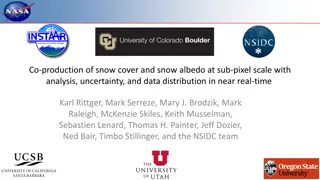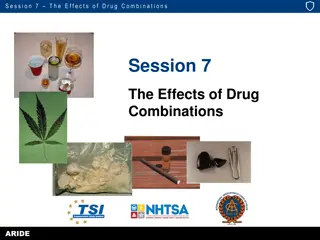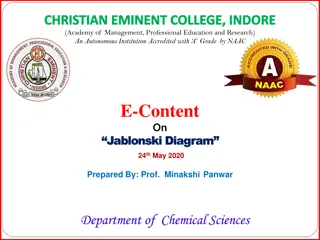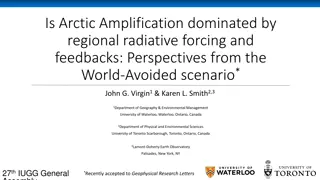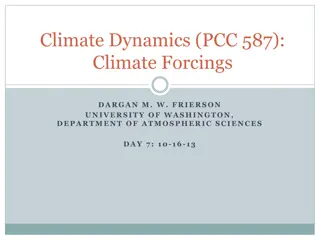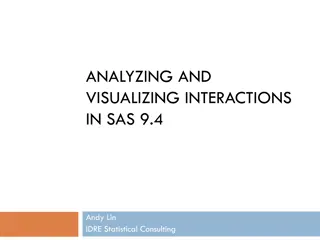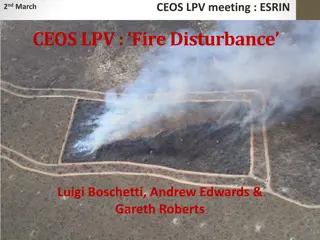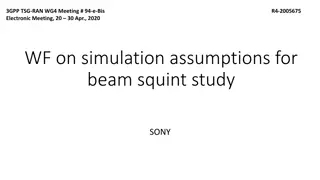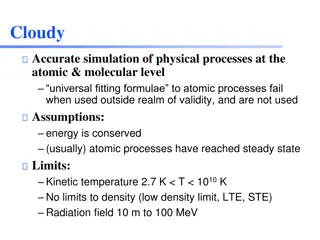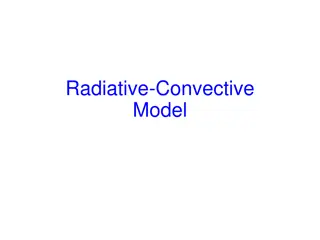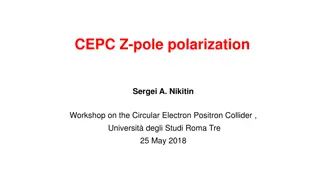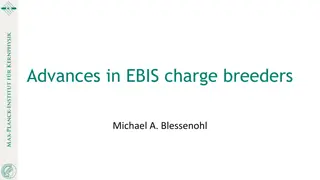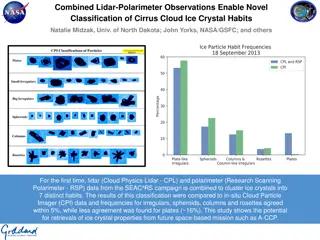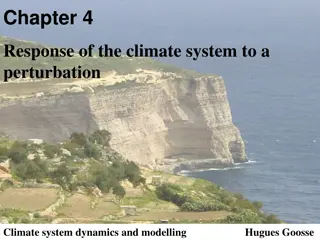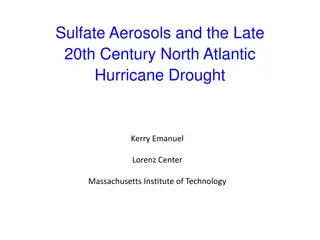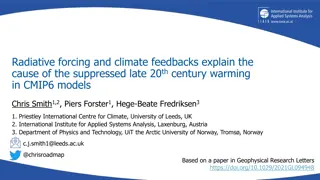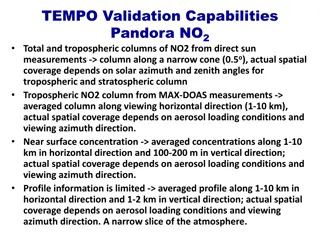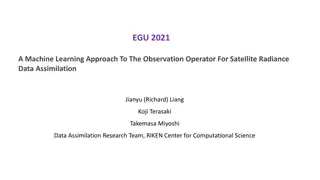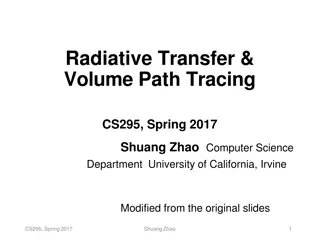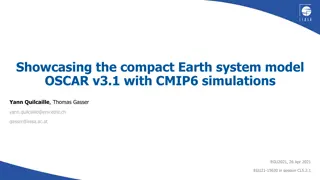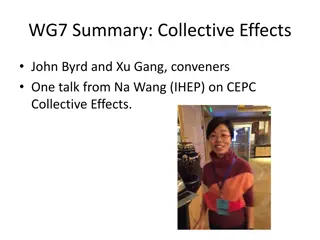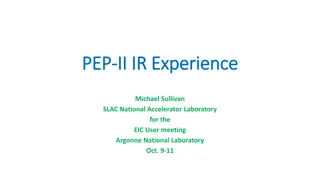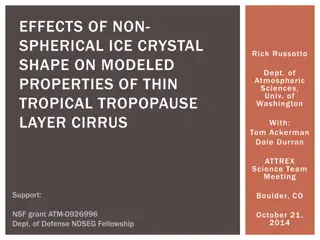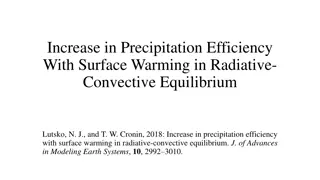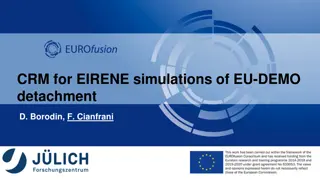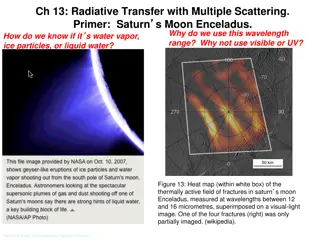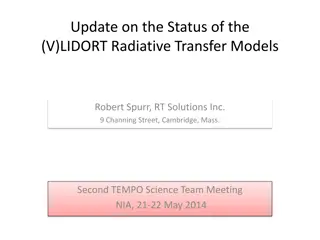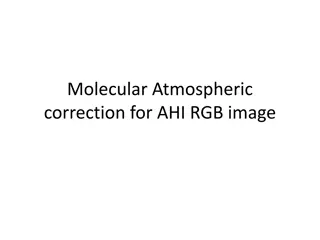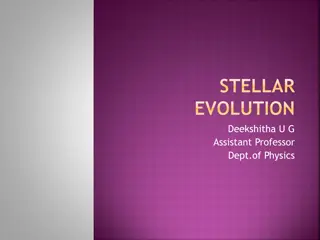Understanding Observed Changes in Atmospheric Solar Reflection and Surface Albedo
Exploring the attribution of changes in Earth's Albedo Shortwave Radiation (ASR) to various processes including atmospheric and surface contributions. The impacts of incident solar radiation, cloud reflection, absorption, and surface albedo are analyzed, along with the radiative sensitivity from iso
0 views • 12 slides
Advancements in Near Real-Time Snow Cover and Albedo Monitoring
Explore the innovative co-production approach for monitoring snow cover and albedo at a sub-pixel scale in near real-time, funded by NASA Terra Aqua Suomi. The project aims to provide valuable insights on snow surface properties, including snow cover fraction, albedo, and radiative forcing, through
6 views • 8 slides
Analyzing Interaction Effects in Composite-Based SEM
Explore the concept of interaction effects in composite-based structural equation modeling (SEM) through topics like the logic of interaction, estimating effects, multigroup analysis, and visualizing effects. Learn about moderators, their role in relationships between variables, and techniques for a
1 views • 23 slides
Understanding the Effects of Drug Combinations in ARIDE Session 7
Dive into Session 7 of the ARIDE program to explore the prevalence of drug and alcohol use, the concept of polydrug impairment, and the potential effects of combining different substances. Learn about null effects, overlapping effects, and how various drug combinations can impact impairment indicato
0 views • 18 slides
Understanding Factorial Designs in Experiments
Factorial designs in experiments allow researchers to study the effects of multiple independent variables simultaneously. This type of design enables the examination of main effects and interactions between factors, providing a comprehensive understanding of the research variables. Main effects refe
1 views • 25 slides
Understanding Biological Effects of Radiation in Radiation Biology Lecture
This lecture by Dr. Zaid Shaker Naji delves into the biological effects of radiation, including deterministic and stochastic effects. It covers mechanisms of damage at the cellular level, such as direct and indirect damage, and discusses somatic and genetic damages that can arise following exposure.
0 views • 10 slides
Exploring Jablonski Diagram and Smart Teaching Tools at Christian Eminent College
Delve into the world of Jablonski Diagram through a comprehensive e-content prepared by Prof. Minakshi Panwar at Christian Eminent College, Indore. Understand energy states, spin, and spin multiplicity in molecules. Discover the concepts of absorbance, non-radiative transitions, and the conversion o
0 views • 11 slides
Regional Radiative Forcing and Feedbacks in Arctic Amplification
Arctic Amplification (AA) is explored in the context of regional radiative forcing and feedbacks in the study by Virgin and Smith (2019). The research investigates the dominance of these factors in the meridional variations of AA, highlighting the contributions of different feedback mechanisms durin
1 views • 22 slides
Understanding Chemistry and Composition in the Climate System
Dive into the intricate relationship between chemistry and composition in the climate system, exploring topics such as radiative effects, stratosphere-troposphere coupling, aerosol-cloud interactions, and the impact of various gases and particulates on radiative forcing. Discover how changes in comp
0 views • 25 slides
Understanding Radiative Forcings in Climate Dynamics
Climate forcings directly impact global temperature by changing solar energy absorption and greenhouse gas concentrations. Shortwave forcings involve changes in solar radiation absorbed, while longwave forcings relate to greenhouse gases affecting the greenhouse effect. Positive radiative forcings l
1 views • 36 slides
Understanding Interaction Effects in Regression Analysis using SAS 9.4
Regression models help analyze effects of independent variables (IVs) on dependent variables (DVs, like weight loss from exercise time). Interactions explore how one IV's effect can be modified by another IV (moderating variable, MV). In this seminar's purpose, techniques to estimate, test, and grap
0 views • 137 slides
CEOS LPV Fire Disturbance Products Overview
CEOS LPV Fire Disturbance products play a crucial role in monitoring and validating active fire and burned area datasets. The current status highlights the validation protocols in place for reference data generation, product inter-comparisons, and the need for validation information for multiple use
0 views • 9 slides
Simulation Assumptions and Performance Degradation Study on Beam Squint in 3GPP Meeting
Background on beam squint in conducted power of transmitted CCs causing radiative domain impairment and gain droop, with a problem statement on degradation of CC2 spherical coverage when CC1 and CC2 are separated by frequency. The study involves refined simulation assumptions to quantify radiative d
0 views • 7 slides
Cloudy: Accurate Simulation of Physical Processes at Atomic & Molecular Level
Cloudy is an open-source software that provides accurate simulations of physical processes at the atomic and molecular levels. It uses universal fitting formulae for atomic processes within valid limits of kinetic temperature and density. The software assists in analyzing gas ionization, chemistry,
0 views • 47 slides
Detailed Overview of a Radiative-Convective Model for Weather Prediction
This detailed overview explores the components of a Radiative-Convective Model, covering convection, radiation transfer, cloud-radiation interaction, and surface fluxes. The model incorporates algorithms and parameterizations to simulate various cloud types, radiative transfer processes, and surface
1 views • 9 slides
Understanding Uncertainties in Direct Radiative Forcing of Aerosols
The uncertainties in the direct radiative forcing of aerosols can be assessed by considering factors such as emissions, lifetime, Mass Absorption Cross Section (MAC), Aerosol Absorption Optical Depth (AAOD), and forcing efficiency. Variations in these factors contribute to the overall uncertainty in
0 views • 9 slides
Radiative Polarization Techniques in CEPC for Precision Measurements of Z-Pole Mass
Prof. Jie Gao led discussions on the CEPC polarization program, focusing on obtaining transverse and longitudinal polarizations. The use of special wigglers to enhance the polarizing effect of the magnetic field was highlighted, reducing the time needed for radiative self-polarization. Strategies to
0 views • 22 slides
Understanding Media Effects on Development: Strong, Limited, and Nil Impact (Continuation)
American psychologists have traditionally believed in strong media effects, attributing direct influence on audiences. However, the limited effects theory emerged in the 1940s, challenging this notion by suggesting media's negligible impact on behaviors such as voting. On the other hand, proponents
0 views • 6 slides
Advancements in Rare Isotope Research at EURISOL Town Meeting
Cutting-edge research and facility developments in the field of rare isotopes were showcased at the EURISOL Town Meeting in INFN - Pisa. Topics included advances in EBIS charge breeders, the ARIEL Extension facility, and the CANREB laboratory with Electron Beam Ion Source technology. Various aspects
0 views • 39 slides
Electronic Structure and Auger Recombination in Silicon Nanocrystals Doped with P, Li, S
This study investigates the electronic structure and Auger recombination rates in silicon nanocrystals doped with phosphorus, lithium, and sulfur. It includes published data on radiative recombination lifetimes, relative rates of recombination, and modeling of nanocrystal structures using computatio
0 views • 13 slides
Novel Classification of Cirrus Cloud Ice Crystal Habits Using Combined Lidar-Polarimeter Observations
Lidar and polarimeter observations from the SEAC4RS campaign were combined to cluster ice crystals into 7 distinct habits, providing insights into cirrus cloud properties. This study showcases the potential for future space-based missions to retrieve ice crystal properties accurately to improve clou
0 views • 6 slides
Understanding Climate System Response to Perturbations: Insights from Hugues Goosse's Chapter 4
Hugues Goosse's Chapter 4 delves into the response of the climate system to perturbations, emphasizing radiative forcing, greenhouse gases, aerosols, and their impacts on Earth's radiative budget. The chapter intricately describes physical feedbacks, interactions involving energy balance, hydrologic
0 views • 40 slides
Understanding North Atlantic Hurricane Drought and Aerosol Impact
This study explores the influence of sulfate aerosols on the late 20th-century North Atlantic Hurricane drought, focusing on the interaction of European sulfate aerosols and African dust. It investigates the radiative forcing effects and variability in hurricane activity, proposing hypotheses relate
0 views • 17 slides
Overview of Phase 0 Experiment with Straw Trackers at HADES
The Phase 0 Experiment involves including straw trackers in the program before PANDA commences at HADES. The upgrade features two new Forward Straw Tracker stations (STS1, STS2) for testing under experimental conditions. The physics program includes radiative hyperon decays, with STS1/2 tasked for s
0 views • 8 slides
Understanding Suppressed Late 20th Century Warming in CMIP6 Models
Recent studies have explored the suppressed late 20th-century warming seen in CMIP6 models compared to CMIP5. The differences in warming patterns are attributed to strong aerosol forcing, with implications for radiative forcing and climate feedbacks. Estimating historical radiative forcing and exami
0 views • 7 slides
Pandora Advanced Validation Capabilities for NO2 Monitoring
Pandora advanced validation capabilities for NO2 monitoring involve measurement techniques such as Total and Tropospheric columns of NO2 through direct sun and MAX-DOAS methods, with emphasis on spatial coverage dependent on various factors. The system provides real-time near-surface concentrations,
0 views • 6 slides
Machine Learning Approach for Satellite Radiance Data Assimilation
This research explores using machine learning as the observation operator for satellite radiance data assimilation, aiming to improve the efficiency of the process. By training the machine learning model with model output and observations, the study investigates reducing the need for a physically-ba
0 views • 14 slides
Understanding Radiative Transfer and Volume Path Tracing
Explore the mathematical model of radiative transfer for simulating light scattering in participating media and translucent materials through volume path tracing. Learn about subsurface scattering and how radiance changes along ray segments in participating media. Delve into the origins and applicat
0 views • 44 slides
Overview of V*LIDORT and Other Radiative Transfer Models by Robert Spurr
The presentation provides an update on the status of V*LIDORT and other radiative transfer models as discussed at the Third TEMPO Science Team Meeting. It covers the LIDORT family overview, upgrades to the codes, new releases for RT models, and accelerated RT developments using PCA. The V*LIDORT cod
0 views • 12 slides
Comprehensive Overview of OSCAR v3.1: A Compact Earth System Model with CMIP6 Simulations
Showcasing the compact Earth system model OSCAR v3.1 and its CMIP6 simulations. OSCAR is a reduced-form Earth system model calibrated to emulate complex models, focusing on radiative forcing, temperatures, precipitation, ocean heat content, aerosols, ozone, and more. Historical periods and scenarios
0 views • 15 slides
Collective Effects in High-Energy Physics Facilities
Collective effects play a crucial role in Higgs factories and high-energy physics facilities. Impedance effects are proportional to beam-induced voltage, with peak bunch current impacting SB effects and average current affecting MB effects. Factors like beam loading compensation and detuning of the
0 views • 5 slides
Satellite Applications in Estimating Earth's Surface Energy Budget
Satellites play a crucial role in estimating the Surface Energy Budget (SEB) by providing data on various components such as Surface Radiation Budget and Surface Turbulent Fluxes. The SEB includes factors like net radiation flux, sensible and latent heat fluxes, and subsurface heat transfer. Satelli
0 views • 38 slides
A Closer Look at PEP-II IR Experience and Beam Parameters
Dive into the details of PEP-II IR layout, beam parameters, and differences/similarities with other accelerator designs like JLEIC and eRHIC. Explore topics such as beam-gas interactions, radiative Bhabhas, and detector acceptance angles, presented at the EIC User Meeting.
0 views • 18 slides
Effects of Non-Spherical Ice Crystal Shape on Modeled Properties of Thin Tropical Tropopause Layer Cirrus
This study explores the impact of non-spherical ice crystal shapes on the properties of cirrus clouds in the thin tropical tropopause layer. Incorporating realistic ice crystal shapes into models affects fall speed, growth rate, and radiative absorption, influencing the time evolution of clouds. The
0 views • 38 slides
Increase in Precipitation Efficiency with Surface Warming
The study examines how surface warming affects precipitation efficiency in radiative-convective equilibrium. Various factors influencing precipitation efficiency, such as microphysical processes and climate sensitivity, are discussed. Model experiments are conducted to test the sensitivity of precip
0 views • 33 slides
Understanding Collisional-Radiative Models for Plasma Detachment Control in Tokamaks
Explore the application of Collisional-Radiative Models (CRM) in EIRENE simulations for plasma detachment control in tokamaks. Learn about detached plasma divertor, main reactions in transport, vibrational states in molecular species, and more through a detailed study of particle species, reaction t
0 views • 10 slides
Understanding Radiative Transfer in Saturn's Moon Enceladus
Exploring the detection and characterization of water vapor, ice particles, and liquid water on Saturn's moon Enceladus using radiative transfer techniques at specific wavelength ranges. The study involves analyzing a thermal map of fractures on the moon and explains the use of wavelengths between 1
0 views • 27 slides
Update on (V)LIDORT Radiative Transfer Models and Upgrades
The update discusses the (V)LIDORT radiative transfer models by Robert Spurr from RT Solutions Inc., highlighting features like pseudo-spherical approximation, Jacobians generation, and new releases. It covers upgrades to the codes, including thread-safe implementation and new capabilities like BRDF
0 views • 11 slides
Atmospheric Correction Techniques for Satellite Image Enhancement
Atmospheric correction is essential for improving the quality of Remote Sensing images captured by satellites. This process involves correcting for the effects of atmospheric gases such as scattering and absorption on the measured Top-of-Atmosphere (TOA) reflectance. Techniques like molecular correc
0 views • 8 slides
Journey of a Star: Stellar Evolution Explained
Explore the stages of stellar evolution, from the birth of a protostar in a nebula to the dramatic transformations leading to the formation of red giants, white dwarfs, and black dwarfs. Understand phenomena like gravitational collapse, temperature changes, radiative processes, and the Chandrasekhar
0 views • 7 slides

